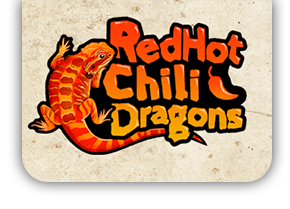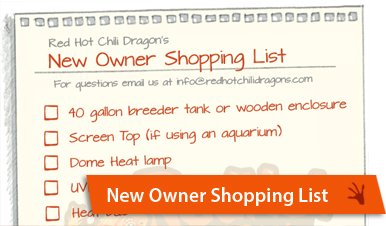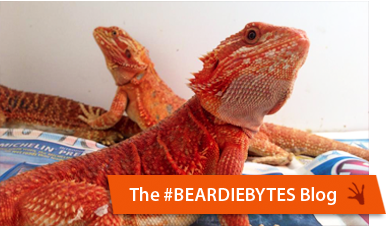Bearded Dragon Care Sheet (Pogona Vitticeps)
Species: Pogona Vitticeps
Size: Hatchlings measure about 4 inches; large adults can be nearly 2 feet in length.
Lifespan: Average captive lifespan is between six and 10 years, though there are reports of specimens living twice that long.
Housing
Hatchlings require an enclosure of at least 20 gallons. It should be longer rather than tall as beardies need a lot of floor space. If given the proper care, it will out grow the 20 gallon very quickly, but is best to start them in a smaller space as a hatchling, as to much space may cause them to become stressed, and they may have a hard time hunting their prey. A 40 gallon breeder tank, (36x18x18), will do it’s whole life, as it becomes an adult, but the more space they have, the happier they will be. As they reach sub adult and adult hood, if you have the space, a custom built enclosure would make a perfect home for your bearded dragon, and he/she would certainly love all the space to run around. The smallest sized enclosure that would be suitable for an adult would be 4 foot long, at least 2 foot wide, and 2-3 foot tall.
For decor it is good to keep it simple. Again, beardies need and want floor space. They should have something to bask on like a log or rock for the hot and cool end, and a hide for both ends of the tank. Make sure to have a shady area for them if needed.Beardies do not like clutter so keep the floor space open
Substrate
There are a lot of options out there as to what to use for a substrate, you can use a non adhesive shelf liner, paper towel, newspaper, reptile carpet, indoor/outdoor carpet, which looks great, or tile, like slate tile which has a rough topping to keep the nails trimmed for you. You can also use sand, but you can only use washed and sifted play sand easily required from any hardware store. You will also have to sift it yourself as there are always tiny pebbles in it which can lead to your beardies death if ingested. NEVER use any pet store sand which has added calcium which is stated to be good for reptiles when it is in fact the #1 killer of reptiles. Due to the calcium in the sand, beardies love the taste and will ingest a lot of it which clumps in their intestines like *kitty litter* causing them to become impacted and over time causing death for them. Remember, beardies do NOT live on sand in the wild, but more of a hard compacted clay, with sandy areas. If you are to use play sand, the basking temps should be 110f-115f so if ingested can be passed easily with the fecal matter. The cool end of the tank should be between 80-85f also. And be sure with the high temps your beardie stays well hydrated.
Heating & Lighting
Bearded Dragons require UVA/UVB lighting in order to ensure a long happy healthy life with you, and without it they cannot survive and will die a slow painful death from MBD, or Metabolic bone disease, which causes the bones to become weak and deform.
UVA, is responsible for normal behaviors such as feeding, how active they are, mating, etc.
UVB, is a non-visible wavelength which allows the synthesis of vitamin D3 which helps to process the calcium offered in the diet, and prevent MBD.
UVC, is also a non-visible wavelength and does not seem to be required by reptiles. UVC is often used as the light source for UV sterilization for killing bacteria, and at high levels of exposure can be harmful to most reptiles.
Some UVB lighting made for reptiles have been found to cause them serious health issues, they emit dangerous levels of UVC, and little to no UVB, These bulbs include compact and coiled lights, as well as the ReptiGlo 10 long tube UVB light. The only safe UVB to use are either the ReptiSUN 10 linear fluorescent tube, or a MVB, (Mercury vapor bulb) The MVB’s emit both UVB and heat all in one, making these the best choice out there. The UVB emissions also last a full year before needing to be replaced unlike the tubes which should be replaced every 6-8 months. The MVB bulbs do come with a few requirements so if you choose to use them, make sure to read the instructions carefully. For the 100 watt MVB, they must be at least 12″ away from the basking spot due to the high emissions of heat and UVB, and at 40 gallon breeder tank is the smallest tank you could use one, otherwise you risk overheating your beardie. If you choose to use the Reptisun 10 linear tube, it must be a distance of 6-8″ from your beardie, and should run the whole length of the top of the cage.
For more info on the bad bulbs not to use, please go to… http://www.uvguide.co.uk/
Beardies also require bright lighting to keep them active as well, if throughout the cage is to dark, they will become inactive and may even refuse to eat, so even adding regular fluorescent lighting will work for brightness, even an old fish tank light.
Basking temps for a baby must be 110-115f, the air around the basking spot should be mid 90’s, and the cool end should be 80-85f. Babies need these temps in order to digest their food properly, and to stay healthy. Temps to low may cause a baby to become impacted from undigested food, and even death.
For heat you can use a dome fixture with regular house hold bulbs, and the wattage will depend on the temperatures so you may have to play around with different wattages to achieve correct temps of 110f. To measure temps accurately, only a digital thermometer with a probe will do, a temp gun, or an infrared thermometer. Stick on thermometers or dials may be off as much as 20 degrees, so those will NOT work.
Bearded dragons do not need any heat source at night as long as the temps do not drop below 60-65f. They need to be able to *shut down* properly at night and cannot do so with heat or light. If temps do drop below 60f, you can use a ceramic heat emitter which will offer heat, but no light at all. Do not use red or any color bulbs as they disturb the sleep, and are harsh on the eyes as well. Black moon glo bulbs are fine that are made for reptiles.
Never use heat rocks, they have caused serious burns to bearded dragons as beardies need heat from above, not below…
Feeding and Hydration
A juvenile Bearded Dragon’s diet will be over 50% insects. They are easier to impact than adults so you will only want to feed them crickets that are the size or smaller than the space between their eyes. There is really only one insect to feed to juveniles and that is crickets. There are also many different worms. Phoenix worms are soft and high in calcium, for example. You’ll want to stay away from mealworms. They’re tempting because Beardies love them and they are so convenient, but do not fall for it. Meal worms are dangerous. They are absolutely indigestible so you will fill your Beardie without providing nutrients. Just look at Bearded Dragon poop after it eats meal worms. Meal worms come out whole. That’s very bad. Baby Bearded Dragons get insects every day. Feed them as many as they can eat. Then try again later. They need a lot of protein.
Adult Bearded Dragons eat mostly veggies. 70% of their diet will be greens and veggies. Every single day, you’ll want to provide a lot of greens and veggies. Do this before you provide insects. They get greens and veggies every single day and insects up to five days a week when they are adults.
We recommend feeding Crickets, Hornworms, Silkworms, Butterworms and Phoenix Worms (also called Repti-worms or black soldier fly larvae)
For Superworms we recommend feeding them once the dragon is 5 months old. Once old enough they make an excellent staple. For younger dragons they may be harder to digest.
DON’T: Don’t bother with mealworms. They have so much chitin (what their exoskeleton is made of) in them that they are basically just filler. They are hard for babies to digest, and once you have an adult dragon, you’ll need too many to keep an adult full. If you do prefer to feed them, please make sure your temps are all correct and proper hydration is provided to ensure the beardie is able to digest them properly. If not it could lead to impaction risks.
You can purchase a small critter keeper to help hold your bugs in. If you’re like me and end up buying 1000’s of crickets a week, you can buy a large rubbermaid sweaterbox to keep them in.
Hydration
Although these guys are from arid locations in Australia, does not mean that they get zero amounts of water. You can provide your dragon with a dish filled with water, but you’ll find that they may not be interested in the water at all. They much prefer lapping up morning dew and rain water than drinking from a large, still body of water.
It’s good to purchase a plant mister and/or eyedropper to “water” your dragons. Lightly mist or drop the water on the tip of your dragons nose. It’s best to do this an hour after lights turn on in the morning. Lightly spray where the dragon is sitting. Do not mist the entire enclosure. This way the enclosure has time to dry before bedtime. You should also mist your dragon’s salad to provide more hydration options.
Supplements
Calcium (no D3) and multivitamin such as Herptivite is needed for a dragon to grow and thrive properly. I would only offer a D3 supplement if there was a problem with the UVB lighting, or some other bone disease going on.
We use the repCal brand ourselves. For juveniles we do a strict regimen of dusting their food source once daily five days a week. Crickets are dusted three times weekly for sub-adult and adult dragons. Our greens and bugs are dusted with a multivitamin twice weekly.
Use calcium every day for babies and every few days for adults. Multi-Vitamins about once or twice weekly should be used. Some feed repcal Dragon pellets every day also.
We can’t stress how important it is that your dragon gets the appropriate calcium supplements each week. Without the required calcium supplement your dragon is at risk for metabolic bone disease.



